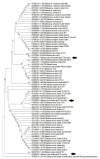Three Cases of Human Babesiosis, Italy, 2017-2020
- PMID: 40439539
- PMCID: PMC12123905
- DOI: 10.3201/eid3106.241776
Three Cases of Human Babesiosis, Italy, 2017-2020
Abstract
We report 3 cases of babesiosis in Italy caused by Babesia species that are rarely reported in humans. The circulation of Babesia spp. among vectors, animals, and humans might be more common than previously thought, and babesiosis might be an underdiagnosed and emerging disease in Italy and Europe.
Keywords: Babesia; Italy; One Health; arthropod-borne diseases; babesiosis; parasites; piroplasmosis; tick-borne; ticks; vector-borne infections; zoonoses.
Figures


References
Publication types
MeSH terms
LinkOut - more resources
Full Text Sources
Miscellaneous

